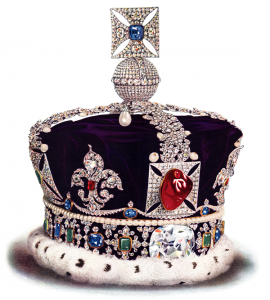The famous Cullinan diamond, which is now the centrepiece of the British Crown Jewels, likely originated in Earth’s lower mantle, right beneath the rigid and stable continental plates, where the mantle is slowly moving or convecting.
The finding is part of ongoing research carried out by Evan Smith and Wuyi Wang at the Gemological Institute of America. The new insight was presented by Smith at the virtual 2020 Goldschmidt Conference organized by US-based Geochemical Society and the European Association of Geochemistry.
Smith and his team concluded that the Cullinan diamond was likely formed in the lower mantle and can be considered a ‘super-deep’ stone after examining an analog, large 124-carat diamond from Gem Diamonds’ (LON: GEMD) Letšeng mine in Lesotho.
According to the researchers, recent analyses of this walnut-sized diamond revealed that it contains remains of an important element: bridgmanite.

“Finding these remnants of the elusive mineral bridgmanite is significant. It’s very common in the deep Earth, at the extreme pressure conditions of the lower mantle, below a depth of 660 kilometres, even deeper than most super-deep diamonds,” Smith said in his presentation. “Bridgmanite doesn’t exist in the upper mantle, or at the surface. What we actually see in the diamonds when they reach the surface is not bridgmanite, but the minerals left when it breaks down as the pressure decreases. Finding these minerals trapped in a diamond means that the diamond itself must have crystallized at a depth where bridgmanite exists, very deep within the Earth.”
By aiming a laser at the tiny inclusions trapped inside the diamond, the researchers found that the way the light scattered (using a Raman spectrometer) was characteristic of bridgmanite breakdown products.
The Letšeng mine diamond is so pure that it doesn’t contain nitrogen in its crystal structure. This characteristic classifies it as a ‘CLIPPIR’ diamond, which is the same category as that of the Cullinan diamond.
“What is special about this one is that it is the first CLIPPIR diamond for which we can firmly assign a lower mantle origin, that is, below 660 kilometres,” Smith said. “Previously, we had known that CLIPPIR diamonds are super-deep and speculated that their depth of origin might span 360 to 750 kilometres depth, but we hadn’t actually seen any that were definitely from the deeper end of this window.”
In the researcher’s view, this finding gives a better idea of exactly where CLIPPIR diamonds come from and also shows that there is some overlap in the birthplace for CLIPPIR diamonds and type IIb diamonds, such as the famous Hope diamond. This rare blue gem was owned by monarchs, bankers, heiresses and thieves until it landed at the Smithsonian National Museum of Natural History in Washington DC.
The overlap that Smith refers to points to a previous study in which the researcher showed that the Hope and other IIb diamonds originate in Earth’s deep mantle and that the boron that gives them a blue hue comes from the bottom of the oceans. To get into the diamond, the element is first dragged hundreds of kilometres by plate tectonics down into the mantle.
“It shows that there is a gigantic recycling route that brings elements from Earth’s surface down into the Earth, and then occasionally returns beautiful diamonds to the surface, as passengers in volcanic eruptions,” Smith said.
Fonte: Mining.com





